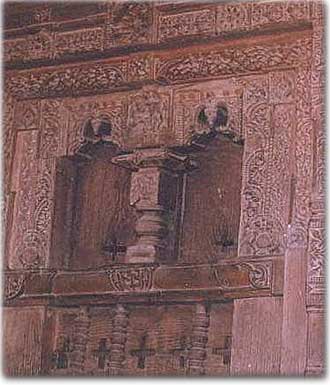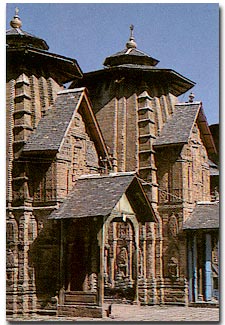God in Himalaya Mountains
India is home to about 900 million Hindus. Excavations in the Indus valley has established that the ancient denizens of this land have worshipped 'Shiva', the God of destruction in the Hindu pantheon. Shiva is often venerated in the form of 'Shivalingam' (phallus) throughout India.
Together with Brahmma (God of Creation) and Vishnu (God of preservation), Shiva forms the Hindu trinity. Hindus have built thousands of temples in the last couple of thousand years. Even a small village will boast of a temple in honour of one of the deities from the vast pantheon.
Often temples are the only remaining structures of the past glory. We will see more examples of these grandeur as we traverse our way through India.
Himalaya is the abode of Shiva and his consort "Shakthi" (literally - power or the driving force). Much of the colourful pomp and ceremony associated with the people of this Himalayan region is probably because of the number of temples,Sikh Gurudwaras, Buddhist monasteries and churches dotting the landscape. People from this region worship about 2000 gods.
A stone's throw from Manali is the magnificent Dhoongri Temple housing Hadimba Devi, built around 450 years ago. As the picture on the left shows, this temple is an example of exquisite word carving. Vashist temple, located in a crest some 3 Km away in Manali, is famous for its stone architecture and the hot sulphur springs channeled to a public bath house.
Ancient capital of Kullu is 'Jagatsukh', which aptly summarizes the theme - Happiness of the World. The patron goddess of the ancient Kullu kingdom is Hadimba Devi. The colourful Dussera festival is celebrated in grand style in this Kullu valley, every October. Vaishno Devi temple in a little cave is on the way to Kullu. Here you will find clusters of temples honouring many of the Hindu Gods.
Manali is a picturesque little town, up the Kullu valley. You will find many photos in these pages here, trying to capture the infinite beauty of this land of God. Solang valley, some 13 Km from Manali, lets you feast your eyes on glaciers and snow capped mountains forming a backdrop to the Rohtang Pass. Rohtang Pass, about 3978 meters (13260 ft) high, some 50 km from Manali was the traditional gateway - the trading routes to the central Asia through Lahaul and Ladakh.
Manali derives its name from Manu, a divine law-giver. Dense pine forests, fertile apple orchards,wild flowers sprouting from the deeply wooded undulating slopes, the gurgling streams of pristine water and the distant view of the snow capped mountains will bring you closer to a communion with the God.
The Lakshminarayan temple in Chamba, pictured here, is dedicated to Shiva and Vishnu. These temples, as is usual in Himalayas, are mostly built of intricately carved wood.
The large Tibetan population adds to the rich heritage of Himalayas. This Monastery houses tangkha paintings and traditional Tibetan handicrafts. You will see many Tibetan shops dealing with carpets, winter clothing,trekking/mountaineering equipments amongst others and 'dhabas' specializing in Tibetan food in these regions. Lahaul and Spiti have many ancient Monasteries. Tabo monastery is the holiest places for Tibetans as it houses the Chorten of Rinchen Tsangpo, the great translator.
Kungri monastery has the added attraction of lamas performing masked dances during the summer festival. Another most sacred temple in North India is Jwalamukhi in Kangra. It means "Goddess of Flame" in Sanskrit and the devotees see Her in the blue flame emanating from a rock in the sanctum.
Paonta Sahib,in Sirmaur district, is devoted to the memory of Guru Gobind Singh and this Gurudwara is most sacred to Sikhs. Manikaran also has Hindu and Sikh shrines. This quaint little town has hot springs and public bath houses as in Vashist temple.
Europeans are not far behind in Himalayas when it comes to religion. Christ church in Shimla's ridge, pictured here lit only by floodlights, is reputed to be the second oldest church in Northern India. Its fine murals depicting faith,hope,fortitude and humanity is a visual treat. St.John's Church in Dharamshala is located in a dense forest with a memorial to Lord Elgin.
|











































